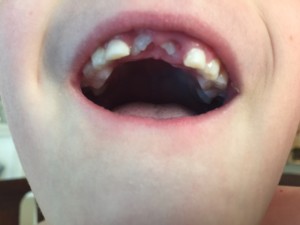Seven year-old’s teeth coming in crooked?
June 15, 2016
My cousin sent me a text the other day—in a panic. Here’s the picture he sent me . 
He happened to look into the mouth of his seven-year-old and noticed that his front teeth are coming in with a bit of a twist to them. “Why is this happening?”, he wanted to know. “His baby teeth were perfectly straight!” My first question for him was whether his son suffers from allergies or frequent tonsillitis. “Yes! Why?”
Why? Because if the airway is obstructed, we humans will breathe through our mouths. With the mouth in an open position, the tongue, which is attached to the lower jaw, does not sit where it normally should—against the roof of the mouth. The tongue is a very strong muscle, and its normal day-to- day activities, like swallowing and talking, help promote the development of the upper jaw. Without this normal influence of the tongue, the upper jaw tends to collapse, or become narrow. The adult teeth developing inside the upper jaw start running out of space, and remember, they are bigger than the baby teeth they are about to replace. It’s kind of like shrinking your jeans in the wash…it makes it a little hard to fit into them, especially if you’ve gained a few pounds. So, these developing teeth start twisting and turning to make their way through the space available to them—they’ll come in crooked!
Other things that will cause an upper jaw to develop narrow are things like a tongue-thrust ( or juvenile swallowing pattern) and thumb-sucking. The swallowing pattern effects the development of the upper jaw similarly to the mouth-breathing pattern. The question there is, which came first? If the upper jaw becomes narrow due to mouth-breathing, the tongue starts running out of room for its normal function and accommodates itself to where it “lives”—close to the lower teeth. A lisp may begin developing with this as well.
Thumb-sucking causes the upper jaw to become narrow because of the upward forces placed upon the developing upper jaw. Right up the middle of the upper jaw is a suture—similar to the soft-spot on a baby’s head. If the thumb is in the mouth long enough and places enough force against the upper jaw, the suture allows changes such that the sides of the upper jaw begin to collapse inward towards the tongue and the roof of the mouth becomes very “deep”.
All of these issues are easily addressed if caught early. Often a palatal expander, commonly called a “butterfly” will be used in order to widen the upper jaw. In the case of a tongue-thrust or thumb-sucking habit, a habit-breaker can be used either before or after expansion.
The American Association of Orthodontists recommends that every child have an orthodontic exam by age seven to evaluate for these and other potential problems that, if caught early, can make treatment during adolescence easier. If you have concerns about your child, we’d be happy to take a look. Schedule a complimentary exam by calling our office.
No Comments
No comments yet.
RSS feed for comments on this post.
Sorry, the comment form is closed at this time.

